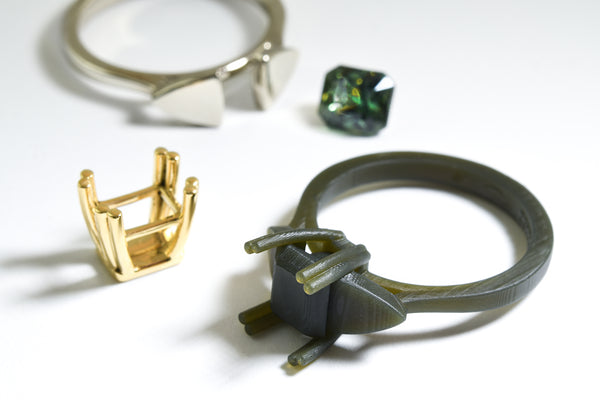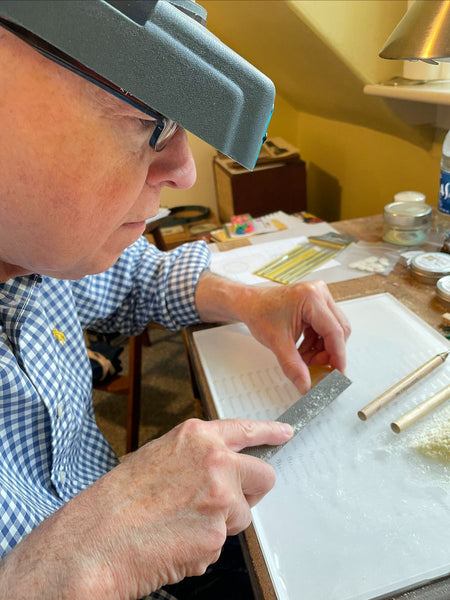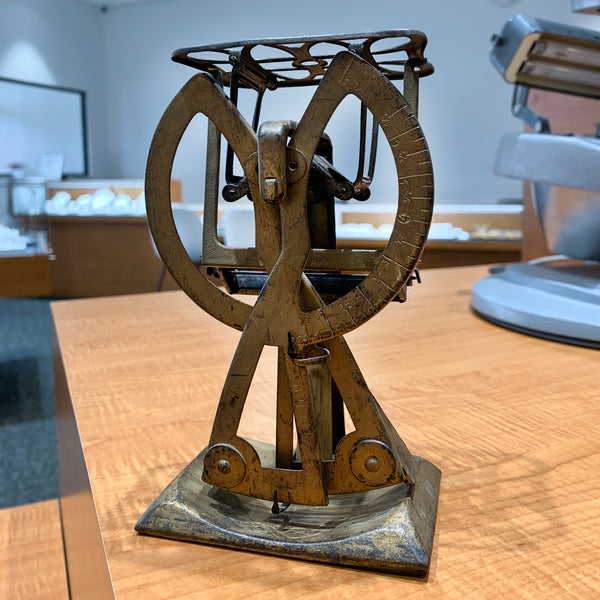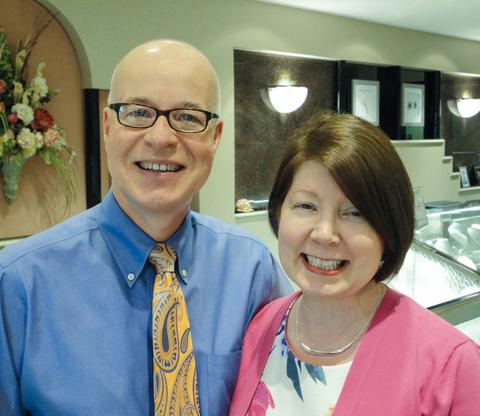Birthstone Engagement Rings: The Hot New Trend
These days, everyone wants their jewelry to be customized: they want to choose something that fits their personality, with their own unique look and feel.
Birthstone engagement rings are a new way to create a truly one-of-a-kind, personalized engagement ring—and it’s one of the breakout wedding trends of the year! In fact, in the first three months of 2019 alone, there were over 34K online searches for “birthstone wedding rings.”
Perhaps more so than any other piece of jewelry, engagement rings hold deep emotional significance and personal meaning. For many couples, alternative engagement rings not only symbolize their engagement, but also reflect their unique individualities. You might be surprised to learn that many birthstones occur in a variety of colors, making it easy to include your birthstone in a ring that is equal parts beautiful and personalized.
Some couples choose to create custom engagement rings with both of their birthstones to create a special representation of their union. There are even ways to incorporate family members, with some couples choosing to include children’s birthstones into their engagement ring design.
If you’re interested in learning more about birthstone wedding rings, you’ve come to the right place. In the sections below, we’ll look at all aspects of birthstone engagement rings, including ring design, selecting the right birthstone, caring for your ring, and a handy guide to birthstones for each month.
Engagement Ring Trends: Designs and Settings
You know that you want to create a birthstone engagement ring—but how do you present it? What’s the best design for you? There are many styles for the ring itself, so you can choose exactly how you’d like to feature your birthstone. Trying on lots of rings is not only fun, but it can be extremely beneficial in helping to choose the right style, shape, and details.
Some women like their ring to sit high above their finger, while others prefer a lower setting. For a high look, you’ll want a prong-set center. If you have an active lifestyle, you may want a low setting with a bezel (which is a metal frame that sits around the gemstone). No matter how the ring is set, you will want a style that is comfortable on your hand, without feeling too high, too low, too chunky, or too dainty.
Trying on different rings and discussing the styles with your jeweler is the best way to ensure that you will be happy with the final design—and to ensure it fits both your personal preferences and your lifestyle.
If you already have a ring that you love, you may even want to consider basing the style of your engagement ring on that basic shape. Before you start trying on different ring designs, here are some recent engagement ring trends to consider:
Traditional setting
A traditional setting puts the birthstone front and center, accenting it with smaller diamonds or other gemstones. Even a traditional design can easily be customized to fit a couple’s style and personality.
Add a halo of diamonds to make the setting more sparkly, or a line of diamonds down the shank of the ring. If you like the look of a traditional diamond, you could choose to insert small birthstone gems along the sides, creating a unique twist on a timeless style.
Three-stone rings
Three-stone rings have recently risen in popularity, and they lend themselves perfectly to birthstone engagement rings. Set your birthstone in the center, with a diamond on each side. Decide if you want diamonds that are almost as large as the center gem or diamonds that are much smaller. Smaller side diamonds make for a daintier ring that creates a more tapered shape on your hand.
Alternatively, the three-stone style allows for a diamond in the center, with birthstones hugging the sides. You can use the same birthstone on each side, or choose to include a birthstone for both the bride and the groom.
A more traditional diamond engagement ring can be transformed into a personal design by adding a “hidden” birthstone on the side of the mounting, below the center diamond. The birthstone won’t be visible when viewed from the top, but when you are wearing the ring, you will see the side and the sparkle from your special gem of choice.
You may choose to take the “hidden” birthstone one step further by truly hiding the birthstone inside the inner ring of the band as a secret between you and your sweetheart!
Stacking bands
Stacking bands are favorites in fashion right now, so you can create a very non-traditional, modern look by using multiple bands to feature your birthstone.
For stacking birthstone wedding rings, you can choose two or three simple bands with alternating diamonds and birthstones. Use alternating patterns or different metals for an added burst of creativity!
Adding a single gemstone hue for each band can give a more vibrant dose of color, or combine shapes within your stack of bands. Round gems have a different look and aesthetic effect than square cuts, such as princess or step cuts.
How to Select Your Birthstone
Selecting your birthstone is, of course, the most important part of deciding on your ring.
First, there are some practical considerations. Ask yourself these questions while designing your birthstone engagement rings:
Am I choosing a durable gemstone?
Not all gemstones are equally durable and suitable for everyday wear. At Plante Jewelers, diamonds, sapphires, and rubies are all approved for gemstone wedding rings by Pierre. While any gemstone can be abraded or fractured, these three are by far the hardest and most able to stand up to decades of daily wear.
Over time, the surface of gemstones (even the durable ones, such as sapphires and rubies) can become abraded. When a gem is abraded, the top can appear scratched and dull, and the sharp, crisp lines of the facets can become slightly rounded. The good news is that the gems can be refinished to restore their beauty.
Should I change my setting to fit my gemstone?
If you must have a softer gem such as opal, pearl, or moonstone, consider a prong setting that will enable the gem to be easily replaced if necessary. Give this some thought—are you going to be okay with knowing you may have to replace a worn gem, or will your sentimental attachment mean you should select a different gem from the beginning?
If your heart is set on having softer gems in your birthstone engagement rings, there are still great ways to include your birthstone without sacrificing wear. You can include a small accent birthstone as part of a diamond ring. Compared to a large center gem, any wear and tear will be much less noticeable—and more manageable—with a smaller, accent gem.
Can I wear my gemstone every day?
If your birthstone doesn’t lend itself to everyday wear, you may want to consider a different gemstone that has significance to the two of you.
Maybe it is the birthstone for the month you met, or the month you will marry. It could even be a gem with a certain color or symbolism that has special significance in your lives. The beauty of birthstone engagement rings is that there are no hard and fast rules—you can choose whatever creates the most meaning for you and your significant other.
Caring for Your Birthstone Wedding Rings
No matter what birthstone or ring design you choose, taking care of your engagement ring will keep the gems and the setting looking great. Learn how to clean the particular gemstones in your ring to ensure that they last a lifetime. Here are some tips for prolonging the beauty of your ring:
-
Have your ring checked every few months. When you bring your ring to Plante Jewelers, we’ll give it a deep cleaning and check the settings to ensure everything is safe and tight. This service is always free!
-
Keep an eye out for rough spots. If you feel a rough area or notice that your ring seems to be snagging on your clothing, don’t wear it. Set it aside and bring it in for checking. If a prong is damaged, wearing the ring may damage it further and result in a lost gemstone.
-
Avoid chlorinated water and chemicals. Don’t wear your ring into a pool or hot tub, and take it off before cleaning with household products. Over time, the chlorine in a pool and in household chemicals can attack the metal alloys (especially in white gold) and can weaken your setting.
- Don’t climb mountains with your ring. Avoid wearing your ring while doing very active things, such as gardening, lifting weights, or rock climbing. Catching the gleam of your birthstone engagement ring while at the top of a mountain might make for a picturesque photo—but a lifetime with your wedding ring will be well worth the tradeoff!
Pierre’s Guide to Birthstones for Engagement Rings
The beauty of birthstone engagement rings—aside from their unique design and bursts of color—is that there are plenty of ways to create a wedding ring with meaning. Whether you choose a gemstone for the month you were born, the month you had your first date, the month your child was born, or anything in between, there is a gemstone for you.
Check out Pierre’s Guide to Birthstones for Engagement Rings below for a month-by-month rundown of each gemstone and what to consider when putting your engagement ring together.
- January (Garnet)—While known for the familiar red, this gem comes in many colors, even green. Pierre says wear it with care.
- February (Amethyst)—Deep purple to lavender. Wear with care to avoid abrasion.
- March (Aquamarine)—This sea-blue beauty can be worn with care.
- April (Diamond)—The time-honored favorite! Change it up by choosing a colored diamond.
- May (Emerald)—Its glorious green is gorgeous; but be aware that it is more susceptible to abrasions if worn every day.
- June (Pearl, Moonstone, Alexandrite)—Pearl and moonstone are soft and may have to be replaced over time. Alexandrite, the color-changing gem, is much more durable.
- July (Ruby)—The King of Gems is also perfect for engagement rings.
- August (Peridot, Spinel, Sardonyx)—All August gems are delicate, and should be worn with care.
- September (Sapphire)—A great choice, and it comes in many colors (except red), so you can choose your favorite.
- October (Opal, Tourmaline)—Opal is a delicate gem that may have to be repolished or replaced in time. Tourmaline, while not the hardest, is a more practical choice for alternative engagement rings.
- November (Citrine, Topaz)—Topaz is the harder of the two. Choose the traditional golden color, or blue topaz for a unique look.
- December (Blue Zircon, Turquoise, Tanzanite)—Of these three, zircon is the most suitable for an engagement ring.
Plante Jewelers offers a wonderful selection of gorgeous gemstones to match your personal style. Visit our store in Swansea to check out our collections or create your own personalized designs. We would love to help you create the birthstone engagement ring of your dreams.
Leave a comment
Comments will be approved before showing up.








Nancy Plante
Author